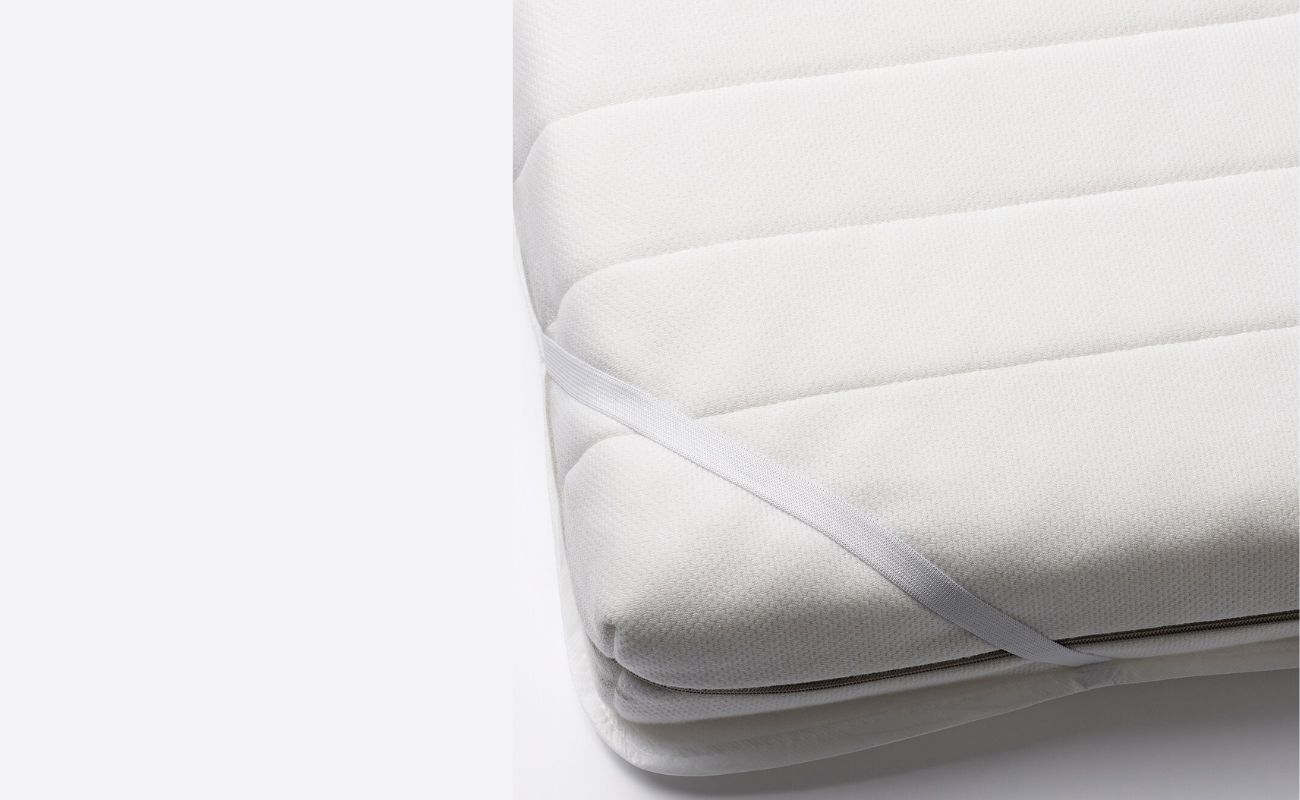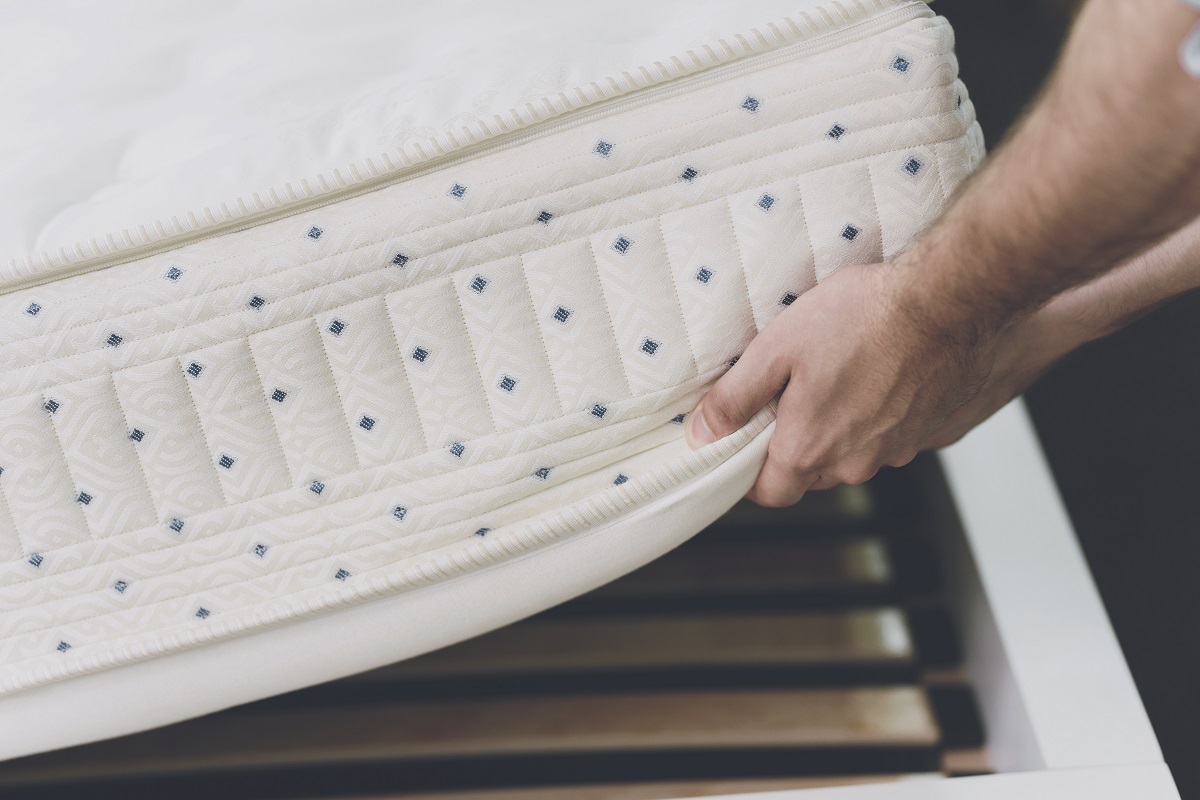Home>Interior Design>How Often Should You Rotate A Mattress?


Interior Design
How Often Should You Rotate A Mattress?
Modified: September 1, 2024
Learn the ideal frequency for rotating your mattress for optimal comfort and longevity. Find out expert tips from the world of interior design.
(Many of the links in this article redirect to a specific reviewed product. Your purchase of these products through affiliate links helps to generate commission for Storables.com, at no extra cost. Learn more)
Introduction
When it comes to getting a good night’s sleep, the condition of your mattress plays a crucial role. A well-maintained and properly rotated mattress can help extend its lifespan and ensure that you wake up feeling refreshed and rejuvenated each morning. However, many people are unsure about how often they should rotate their mattress and why it is important to do so.
In this article, we will delve into the topic of mattress rotation and provide you with all the information you need to know. We will explore the importance of rotating your mattress, factors to consider when deciding on the rotation frequency, signs that indicate your mattress needs to be rotated, as well as the proper techniques for rotating a mattress. Additionally, we will highlight the benefits of regular mattress rotation and answer some frequently asked questions to address any concerns you may have.
Mattress rotation involves flipping or turning the mattress to even out wear and prevent sagging or indentations. This process redistributes the weight and pressure placed on the mattress and helps maintain its shape and support over time. By implementing a regular rotation schedule, you can maximize the lifespan of your mattress and enhance your sleeping experience.
So, if you’re ready to learn more about how to properly care for your mattress through regular rotation, let’s dive in!
Key Takeaways:
- Regularly rotating your mattress every three to six months can prevent sagging, extend its lifespan, and improve sleep quality by ensuring even wear distribution.
- Factors such as mattress type, age, and sleeping habits should be considered when determining the ideal rotation frequency for your mattress.
Read more: How Often Should You Change Mattress
Importance of Rotating a Mattress
Rotating a mattress is a crucial aspect of mattress maintenance that is often overlooked. Here are several reasons why rotating your mattress is important:
- Even wear distribution: Over time, mattresses tend to experience uneven wear and tear. By rotating the mattress, you ensure that the weight and pressure are distributed evenly across all areas. This helps to prevent excessive sagging or indentations, allowing you to enjoy a more comfortable and supportive sleep surface.
- Prolongs mattress lifespan: Rotating a mattress regularly can significantly extend its lifespan. By reducing the concentration of pressure in specific areas, you minimize the risk of irreparable damage and ensure that your mattress remains in good condition for an extended period.
- Enhances sleeping comfort: As a mattress becomes worn and develops uneven areas, it can negatively impact your sleeping comfort. By rotating the mattress, you eliminate these uncomfortable spots and create a more uniform sleeping surface, ensuring a better night’s sleep.
- Prevents body impressions: Body impressions are depressions or indentations that form on the surface of a mattress over time due to prolonged pressure. Regularly rotating the mattress can help prevent these body impressions from forming and maintain a smoother, more supportive sleeping surface.
- Reduces allergen buildup: Mattresses can accumulate allergens such as dust mites, dead skin cells, and pet dander over time. By rotating your mattress, you expose different areas to fresh air and sunlight, which helps to minimize the buildup of allergens and create a cleaner sleeping environment.
It’s important to note that the specific benefits of mattress rotation may vary depending on the type and materials of your mattress. However, regardless of the type, regularly rotating your mattress is a simple yet effective way to ensure its longevity and maintain optimal sleep quality.
Factors to Consider
When determining how often you should rotate your mattress, there are several factors that you should take into consideration:
- Mattress type: The type of mattress you have plays a significant role in determining the ideal rotation frequency. Innerspring mattresses typically require more frequent rotation, as the coils can start to wear down and lose support over time. Memory foam and latex mattresses, on the other hand, may only need rotation once or twice a year.
- Mattress age: The age of your mattress can also impact the rotation schedule. Newer mattresses generally require less frequent rotation compared to older ones. It is recommended to rotate a new mattress every three to six months for the first year, and then decrease the frequency to once or twice a year thereafter.
- Sleeping habits: Your sleeping habits and body weight can affect the wear and tear on the mattress. If you tend to sleep in the same position or on one side of the bed consistently, you may need to rotate the mattress more frequently to prevent uneven compression and sagging in specific areas.
- Manufacturer’s recommendations: It’s important to check the manufacturer’s guidelines and recommendations for your specific mattress. They may provide specific instructions on how often and in which direction the mattress should be rotated.
- Personal comfort preference: Ultimately, your personal comfort should also be a factor in deciding how often to rotate your mattress. If you notice any discomfort or changes in the quality of your sleep, it may be a sign that the mattress needs to be rotated more frequently.
Considering these factors will help you determine the most appropriate rotation schedule for your mattress, ensuring that it remains in optimal condition and provides you with a comfortable and supportive sleep surface.
Types of Mattresses and Rotation Frequency
The type of mattress you own plays a significant role in determining the ideal rotation frequency. Here are some common types of mattresses and their recommended rotation schedules:
- Innerspring Mattresses: Innerspring mattresses are constructed with metal coils that provide support and bounce. Due to the nature of the coil system, these mattresses typically require more frequent rotation. It is advisable to rotate an innerspring mattress every three to six months to ensure even wear distribution.
- Memory Foam Mattresses: Memory foam mattresses contour to the shape of your body and provide excellent pressure relief. They tend to have a more specific weight distribution, so rotating them less frequently is usually sufficient. Rotating a memory foam mattress once or twice a year is generally recommended.
- Latex Mattresses: Latex mattresses are made from natural or synthetic latex foam, known for their resilience and durability. Similar to memory foam mattresses, latex mattresses do not require frequent rotation. Rotating them once or twice a year helps to maintain their shape and prolong their lifespan.
- Hybrid Mattresses: Hybrid mattresses combine the support of innerspring coils with the comfort of foam or latex layers. The rotation frequency for hybrid mattresses usually depends on the specific materials used. It is recommended to follow the rotation guidelines based on the dominant material in the hybrid construction.
Keep in mind that these rotation frequencies are general guidelines, and it’s important to check the manufacturer’s recommendations for your specific mattress. They may provide more specific instructions based on the design, materials, and construction of the mattress.
Regardless of mattress type, consistently rotating your mattress as recommended can help maintain its structural integrity and ensure that you experience optimal comfort and support for years to come.
Signs that Your Mattress Needs to be Rotated
Regularly rotating your mattress is essential for maintaining its longevity and comfort. Here are some signs that indicate it’s time to rotate your mattress:
- Sagging or indentations: If you notice visible sagging or indentations on your mattress, especially in areas where you frequently lie, it’s a clear indication that the mattress needs rotation. Rotating the mattress helps distribute the weight evenly and prevent further sagging.
- Uneven sleep surface: A mattress that no longer feels even or level to sleep on is a sign that it needs rotation. If you find yourself rolling towards one side of the bed or struggling to find a comfortable position, rotating the mattress can help restore a balanced sleep surface.
- Body impressions: Body impressions are visible indentations or imprints left on the mattress surface after you get up. If these impressions remain for an extended period or become more apparent, it’s a sign that the mattress is experiencing uneven compression and needs to be rotated.
- Increased discomfort or pain: If you are experiencing increased discomfort or waking up with aches and pains, it could be an indication that your mattress has deteriorated in certain areas. Rotating the mattress allows you to distribute the pressure evenly and alleviate discomfort.
- Changes in sleep quality: If you notice a significant decline in your sleep quality, such as difficulty falling asleep or waking up feeling restless, it could be a result of an uneven or worn-out mattress. Rotating the mattress can help restore proper support and improve your sleep experience.
It’s important to address these signs promptly by rotating your mattress. Regular rotation will help to delay the development of permanent indentations or sagging and ensure that you continue to enjoy a comfortable and supportive sleep surface.
Rotate your mattress every 3-6 months to ensure even wear and prolong its lifespan. This helps prevent sagging and maintains support.
Read more: How Often Should You Change Your Mattress?
Proper Techniques for Rotating a Mattress
Rotating your mattress properly is essential to ensure an even distribution of wear and maximize its lifespan. Here are some steps to follow for proper mattress rotation:
- Check the manufacturer’s guidelines: Before rotating your mattress, refer to the manufacturer’s instructions for any specific recommendations or restrictions regarding rotation. This will help you ensure you are following the proper technique for your particular mattress.
- Clear the area around the bed: Make sure there is enough space around the bed to maneuver and rotate the mattress without any hindrances. Remove any objects or furniture that may obstruct the rotation process.
- Enlist the help of another person: Mattresses can be heavy and bulky, so it is advisable to have another person assist you with the rotation process. This will make it easier and safer to handle the mattress.
- Rotate the mattress 180 degrees: If you have a non-pillow top mattress, rotate it 180 degrees so that the foot of the bed becomes the head. This ensures that the areas that were previously supporting the foot of the bed now distribute the weight evenly across the mattress.
- Flip the mattress: If you have a two-sided mattress, in addition to rotating it, you can also flip it over. This will further promote even wear distribution. However, note that not all mattresses are designed to be flipped, so check the manufacturer’s guidelines before doing so.
- Reposition the mattress: Once the rotation and flipping are complete, carefully reposition the mattress back to its original position on the bed frame. Ensure that it is aligned properly and centered on the frame.
- Repeat the rotation process: Depending on the recommended rotation schedule for your mattress, continue to rotate and flip it at regular intervals to maintain even wear distribution. This will help prolong the lifespan of your mattress and ensure optimal comfort.
Following these proper techniques for mattress rotation will not only help maintain its condition but also prevent any potential damage during the process. Remember to always prioritize your safety and seek assistance if necessary.
Benefits of Regularly Rotating a Mattress
Regularly rotating your mattress offers several benefits that help maintain its condition and maximize your comfort. Here are some advantages of implementing a consistent mattress rotation schedule:
- Even wear distribution: One of the key benefits of rotating a mattress is the even distribution of wear and tear. By regularly rotating the mattress, you prevent certain areas from becoming more worn than others. This helps to extend the lifespan of the mattress and ensures consistent support and comfort throughout.
- Reduced sagging and indentations: Over time, mattresses tend to develop sagging and indentations, especially in areas where there is more body weight and pressure. By rotating the mattress, you distribute the weight more evenly, minimizing the risk of sagging and maintaining a smoother sleep surface.
- Enhanced durability: Proper rotation can significantly extend the lifespan of your mattress. By regularly redistributing the weight and pressure, you reduce the likelihood of permanent damage such as broken or worn-out springs, foam degradation, or sinking spots. This helps to keep your mattress in good condition for a longer period.
- Improved sleep quality: A well-rotated mattress provides better sleep quality. By eliminating uneven spots, sagging, or discomfort, you create a more supportive and comfortable sleep surface. This can lead to a more restful and uninterrupted sleep, improving your overall well-being and daytime productivity.
- Prevention of allergen buildup: Regular mattress rotation helps to minimize the accumulation of allergens such as dust mites, dead skin cells, and pet dander. By exposing different areas of the mattress to fresh air and sunlight, you reduce the opportunity for allergens to settle, promoting a cleaner and healthier sleep environment.
- Cost-effective: By properly maintaining and rotating your mattress, you can potentially save money in the long run. Regular rotation can prevent premature wear and damage, reducing the likelihood of having to replace your mattress sooner than expected.
Overall, regularly rotating your mattress is an essential aspect of mattress care and maintenance. It helps to ensure even wear distribution, prevent sagging, extend the mattress’s lifespan, and enhance your sleep quality. By implementing a consistent rotation schedule, you can enjoy a comfortable and supportive sleep surface for years to come.
Frequently Asked Questions
Here are some commonly asked questions regarding mattress rotation:
-
1. How often should I rotate my mattress?
The frequency of mattress rotation depends on factors such as the mattress type, age, and manufacturer’s recommendations. Generally, rotating the mattress every three to six months is recommended, especially for innerspring mattresses. Memory foam and latex mattresses may only need rotation once or twice a year. -
2. Can I rotate a one-sided mattress?
One-sided mattresses, often referred to as no-flip mattresses, are not designed to be flipped. However, you can still rotate them 180 degrees to achieve even wear distribution. -
3. How do I know which direction to rotate the mattress?
To achieve optimal wear distribution, rotate the mattress 180 degrees so that the foot of the bed becomes the head. This ensures that different areas of the mattress experience the weight and pressure evenly. -
4. Do all mattresses require rotation?
While most mattresses benefit from regular rotation, some mattress types may not require it. For example, some high-density memory foam mattresses or latex mattresses may have more uniform wear patterns and may not need as frequent rotation. Check with the manufacturer’s guidelines for specific instructions. -
5. Can mattress toppers affect the need for rotation?
Mattress toppers are additional layers of cushioning placed on top of the mattress. While they can provide extra comfort, they do not affect the need for mattress rotation. The rotation schedule should be followed based on the underlying mattress. -
6. What can I do to extend the lifespan of my mattress?
In addition to regular mattress rotation, you can take other steps to prolong the lifespan of your mattress. These include using a mattress protector, keeping it clean and free of stains, avoiding excessive jumping or putting too much weight on it, and following any specific care instructions provided by the manufacturer.
If you have more specific questions about your mattress or its maintenance, it is recommended to consult the manufacturer’s guidelines or seek guidance from a mattress expert.
Conclusion
Rotating your mattress regularly is a simple yet effective way to ensure its longevity and maintain optimal sleep comfort. By implementing a consistent rotation schedule, you can evenly distribute wear and tear, prevent sagging, and extend the lifespan of your mattress.
Consider factors such as the type of mattress, its age, and your personal sleeping habits to determine the ideal rotation frequency. In general, rotating a mattress every three to six months is recommended, but this can vary depending on the specific mattress and manufacturer’s guidelines.
Proper techniques for mattress rotation include checking the manufacturer’s instructions, clearing the area around the bed, enlisting the help of another person, rotating the mattress 180 degrees or flipping it if applicable, and carefully repositioning it. Following these steps will help maintain the structural integrity of your mattress and ensure even wear distribution.
The benefits of regularly rotating your mattress are numerous. From preventing sagging and body impressions to improving sleep quality and reducing allergen buildup, proper rotation promotes a comfortable and supportive sleep surface. Additionally, it can be a cost-effective way to prolong the lifespan of your mattress, saving you money in the long run.
If you have specific questions or concerns about your mattress, always refer to the manufacturer’s guidelines or seek advice from a mattress expert. By taking proper care of your mattress through regular rotation, you can enjoy a restful night’s sleep and wake up feeling rejuvenated each morning.
Frequently Asked Questions about How Often Should You Rotate A Mattress?
Was this page helpful?
At Storables.com, we guarantee accurate and reliable information. Our content, validated by Expert Board Contributors, is crafted following stringent Editorial Policies. We're committed to providing you with well-researched, expert-backed insights for all your informational needs.















0 thoughts on “How Often Should You Rotate A Mattress?”